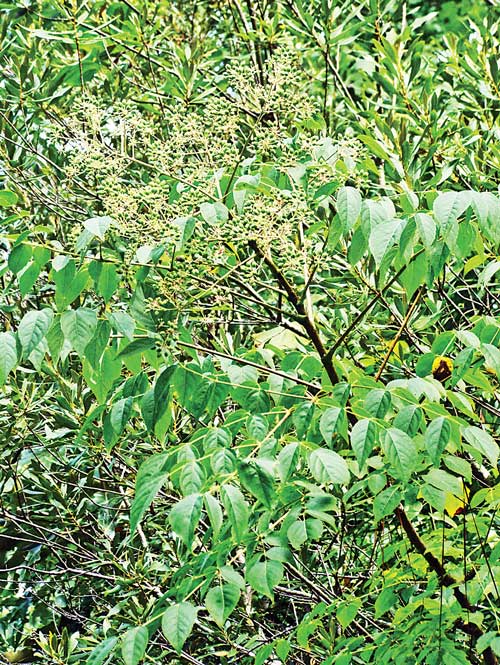Flora readers have influence

PHOTO BY CHRISTIAN FISHER. Swallowtails converge on Chatham County devil’s walking stick.
By Ken Moore
Flora Columnist
For weeks now, I’ve wanted to describe the lovely fern glade at the base of the mountain at Occoneechee Mountain State Natural Area. The 2-mile trail encircling that mountain is one of the premier hikes in our area. In spite of this summer’s heat and drought, that fern glade is still lime-green fresh looking.
But all the butterflies and other interesting critters moving about on the summer wildflowers keep sidetracking me. So this past week, as I was once again beginning to focus on that fern glade, I received an enthusiastic description from Chatham County reader Christian Fisher about all the butterflies on devil’s walking stick, Aralia spinosa, in the community’s woods. The note was accompanied by a wonderful image of yet another native plant “butterfly magnet.†That image was so engaging that I thought, “Well now, devil’s walking stick is a plant worthy of attention; I should focus on that sometime.â€
The very next day, Ron Flora, gardener and staff member of the Carrboro branch of the State Employees’ Credit Union, and I engaged in a short over-the-counter plant conversation. He was curious about a plant he saw stretching out from entangling kudzu along the woodland trail at the N.C. Museum of Art. It was covered with all sorts of butterflies. After hearing a few more of his keen observations, I responded that it must be a devil’s walking stick he had seen. So, that sealed it. This week, the spotlight is on Aralia spinosa.
This small tree is fairly common along streams and in low moist areas scattered throughout our state. It’s seldom noticed until large clusters of small cream-colored flowers or dark purple-black berries show up along forested roadsides. The 2-to-4-foot-wide double-compound leaves are unforgettable.
If you discover the plant during a leisurely walking excursion, you will notice menacing thorns armoring the stems. Since devil’s walking stick commonly suckers, you’ll most likely find a grove or thicket of those spiny stems. You dare not grab hold, for obvious reasons. Only the Devil, himself, would dare do that.
It’s interesting that devil’s walking stick shares close kinship with two quite different plants: ubiquitous English ivy, Hedera helix, and the much-revered magical herb, ginseng, Panax quinquefolium. All three bear tiny flowers in globe-shaped clusters characteristic of the plant family, Araliaceae.
For easy viewing, there is a thicket at the edge of the big magnolia grove in the Coker Arboretum. And there is a smaller thicket along the edge of the sand hill habitat just inside the cattail gate at the N.C. Botanical Garden. Regular commuters up and down South Columbia Street may notice the thicket along the woodland edge near the Ambulatory Care Center. Keep your eyes open for other Aralia spottings.
And about that Occoneechee Mountain fern glade, don’t wait for my description; enjoy discovering it yourself.
Email Ken Moore at flora@carrborocitizen.com.

PHOTO BY KEN MOORE. Touch softly devil’s walking stick’s armored stem.

PHOTO BY KEN MOORE. Once discovered, you’ll never forget devil’s walking stick.

PHOTO BY KEN MOORE. Sneaky praying mantis finds the flower and berry clusters of devil’s walking stick a great dining hall.


Comments are closed.